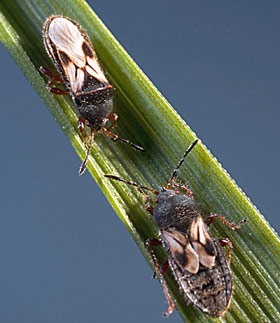Chinch Bug (Hairy Chinch Bug), Blissus hirtus

David Shetlar, The Ohio State University, Bugwood.org.
IPM Steps to Reduce Chinch Bugs
1. Sample for Pest
Confirm the presence of chinch bugs before you treat.
Where to find it while inspecting: Irregular, browning areas of turf in sunny areas may prove to be chinch bug damage. Look for adults in the thatch area of failing turfgrass where they feed on the lower stem and crown. This is also a good opportunity to sample with the “flotation method” using a tin coffee can. NOTE: Bigeyed bugs are very similar and are a beneficial insect, often mistaken for chinch bugs. Bigeyed bugs are welcome in your turf and landscape.
2. Proper ID
Are they chinch bugs?
Size and Appearance: Adults are black with white markings on their wings and are only 1/5" long. Nymphs are miniature versions for the most part but do not have wings; instead they have orange-red markings.
3. Learn the Pest Biology
What is the life cycle of chinch bugs?
Life Cycle: Chinch bugs overwinter in protected areas such as leaf litter and along foundations. In spring, adults move into open areas and females begin to lay eggs, daily for about 3 weeks. Nymphs (small versions of adults, there is no larval stage for chinch bugs) begin to feed on plants through sucking mouthparts over a period of 1–3 months depending on weather. There is usually two generations per year, so adults and nymphs overlap throughout the season.
Preferred Food Sources: Turfgrass stems and leaves.
Preferred Habitat: During the time they are causing damage, you will find them in the thatch portion of turf. Off-season, adults stay in protected areas of leaf litter.
4. Determine Threshold
How many chinch bugs are too many?
Threshold: In healthy turf that receives irrigation during drought, a few chinch bugs can be tolerated. Presence of beneficials like ground beetles and bigeyed bugs may be able to keep the population to a level that will limit damage. Generally 20–25 chinch bugs per square foot will result in visible damage.
5. Choose Tactics
Creating a healthy soil condition and understanding turfgrass’s needs is the first step in reducing turf pests. What can I do to treat, reduce, or prevent chinch bugs?
Best Management Practices: Select or introduce endophytic cultivars of perennial ryegrass or tall fescue if those grasses are appropriate for your particular field. Give your turfgrass optimal conditions to withstand pest pressure: maintain proper soil pH: 6.0 to 6.8 (test every 3–5 years). Fertilize at the proper time for turfgrass root development, primarily fall (late spring at times when turf is weak and thin), irrigate if needed, mow at proper height (removing no more than 1/2 of the blade), amend poor soil, choose proper turfgrass seed for your conditions, buy quality seed, overseed thin spots in fall or early spring, remove thatch. Avoiding use of insecticides will usually mean natural enemies (beneficial insects) will also be doing their job to combat pests. Two biological treatments are: introduction of the natural enemy bigeyed bug, and use of Beauveria bassiana, an entomophagous fungus.
Treatment Methods: There are insecticide treatments available in intense situations. Consult a certified pesticide applicator with a working knowledge of IPM.
6. Evaluate
Was the tactic successful? Record the date pests were first noted, and the tactic you used, and its success. Use one of our RECORD KEEPING tools.
For More Information:
Penn State Extension: Chinch Bugs in Home Lawns
FLOTATION METHOD OF SCOUTING. Soften the soil a little by pouring some water out of a watering can. Insert one end of the can into the ground at least two or three inches, leaving at least four inches above the ground. Fill the can with water from a garden hose (with moderate pressure) and wait about five minutes. Insects will float to the surface of the water, where you can count them.
Remember:
When a pesticide application is necessary, all necessary and required precautions are taken to minimize risk to people and the environment and to minimize risk of pesticide resistance or pest resurgence. Pesticide use in your school may be prohibited or regulated by local policies or state and federal regulations. Risk reduction methods can include, but are not limited to, spot-treatment, the use of gel or paste bait formulations placed in inaccessible locations, injection into a crack or crevice, and other methods that reduce potential exposure.